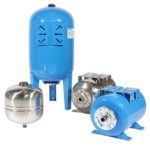How to size expansion vessels and pressure vessels?
The selection and sizing of vessels is very important depending on the application type and system characteristics. Many a pump has failed due to too many starts because of incorrectly specified pressure vessels, and undersized expansion vessels can cause a range of failures.
This blog will give you a quick guide on how to size both expansion vessels for heating/cooling systems and potable pressure vessels.
Heating Expansion Vessels
Heating expansion vessels are selected and commissioned taking into account three system characteristics; maximum system temperature, system volume and static head above the vessel. The system volume and operating temperature range dictates the pressure vessel size and the static system head dictates the pre-charged pressure. There are however a couple of quick simple methods to this – based on the assumption that the system is 82℃ / 71℃ flow and return and a system pressure up to 1.5 bar.
A simple rule of thumb is 10% of the system volume – rounding up to the nearest vessel size. Allow for 10 litres per standard radiator and an additional 10 litres for a boiler. For example; a system with 10 radiators and a modern boiler would equate to an approximate system volume of 110 litres. 10% would equate to 10 litres – therefore using this calculation a 12 litre vessel would be suitable.
Another ‘rule of thumb’ method of calculating vessel size is using the boiler KW size. The method used is to allow for 1 litre capacity per kW. For example; 7kW output would equate to an 8 litre vessel.
Both the above methods tend to slightly oversize the vessel capacity. Please see below table for more accurate selections:
| Vessel Size | System Volume Range (litres) | Boiler KW |
| 5 Litre | 0-70 | 7 – 9 |
| 8 Litre | 75-110 | 12 – 14 |
| 12 Litre | 115-170 | 17 – 22 |
| 18 Litre | 175-230 | 19 – 33 |
| 24 Litre | 235-340 | 26 – 43 |
| 35 Litre | 345-490 | 38 – 63 |
| 50 Litre | 495-790 | 54 – 90 |
| 80 Litre | 795-990 | 86 – 144 |
| 100 Litre | 995-1200 | 108 – 180 |
Note: these are guides only – and may not apply in every scenario. Please contact us if you are unsure!
Browse and buy Expansion Vessels online from Tradepumps
Assuming a 1.0 bar system pressure when the system is ‘cold’, the expansion vessel will normally be sized to ensure the running pressure at operating temperature rises by approx 0.5 Bar to 1.5 bar running pressure. Therefore if the pressure vessel is installed at the top of the system the pre-charge pressure of the vessel will be equal to the ‘cold-fill’ pressure (1.0 Bar). If the pressure vessel is installed at a lower point of the system the static pressure of the system above the vessel should be added to the pre-charge pressure. E.g. if the static height of the top point of the system is 5 metres above the pressure vessel, the pre-charge pressure should be 1.0 bar + 5 metres = 1.5 bar.
Potable Pressure Vessels – Variable Speed Pumpsets
To calculate what size pressure vessels you will need for a pressure boosting system, the easiest method is by taking the design flow rate of the pump or pump system.
The ‘rule of thumb’ calculation is that the pressure vessel size is equal to 6 seconds of maximum flow. For example: if the design maximum flow rate of a booster set is 3 l/s – the required vessel size would be 18 litres.
It is important to remember here that on applications like this, the larger the vessel the smoother the system will run, and less energy will be required switching the pumps on and off. Additionally, if space is a constraint, vessels can be installed in tandem on a common manifold on the discharge pipework.





